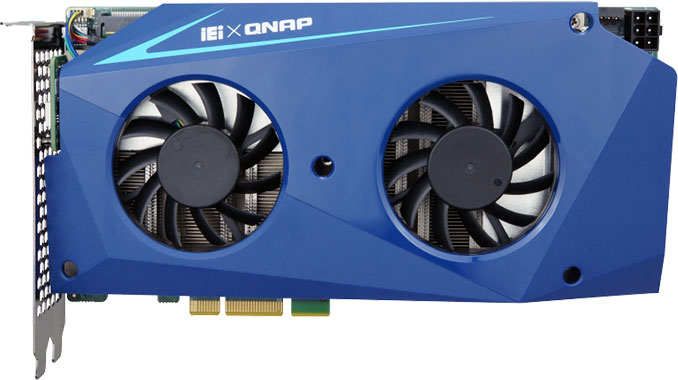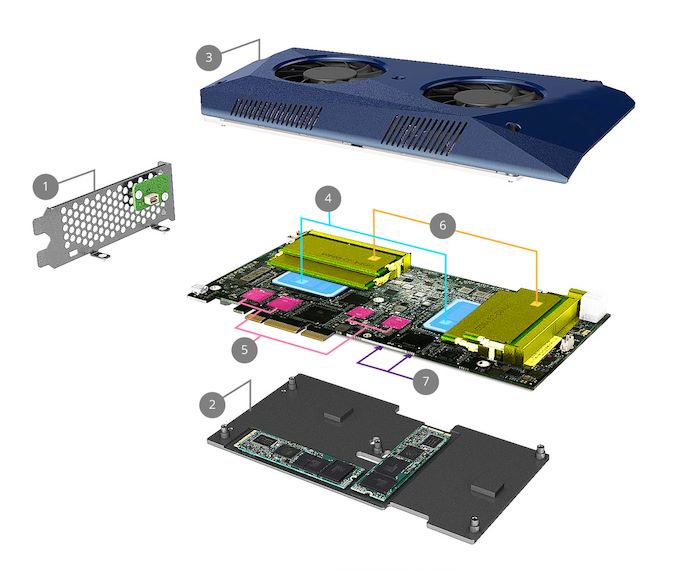QNAP Launches Mustang-200 Compute Accelerator for Network Attached Storage
by Anton Shilov on November 21, 2018 4:30 PM EST
QNAP has released a special-purpose accelerator based on two Intel CPUs that is designed to significantly boost the processing capabilities of NAS boxes and even PCs. QNAP’s Mustang-200 can speed up access to data located on a NAS box, but can also be used to increase image processing capabilities of NASes used for surveillance, run AI and ML apps, or speed up virtual machines.
The QNAP Mustang-200 accelerators are PCIe 2.0 x4 cards based on two Intel Kaby Lake CPUs (Core i7-7567U, Core i5-7267U or Celeron 3865U) outfitted with their own 4 - 16 GB of DDR4 memory as well as 512 GB Intel 600P SSDs (Core i5/i7 only). Each node has its own 10 GbE NIC and runs its own copy of QNAP’s mQTS operating system, thus offering a familiar functionality to those who use NAS products from QNAP.
By adding a Mustag-200 card, owners of QNAP NASes can increase the processing power of their systems from one processor to three, which can be used by a variety of applications supported by mQTS. Since the cards have their own resources, administrators can deploy different applications on different nodes using the Mustang Card Manager program and physically isolate them from each other. It is noteworthy that the Mustang-200 accelerators can be installed not only into NAS boxes, but also into regular PCs and be used for a variety of applications.
| QNAP Mustang-200 Cards | ||||
| CPU (x2) | RAM (per CPU) | SSD (per CPU) | ||
| Mustang-200-i7-1T/32G-R10 | Intel Core i7-7567U - 2C/4T, 3.5GHz, Iris Plus Graphics 650 | 16 GB | Intel 600p 512 GB |
|
| Mustang-200-i5-1T/32G-R10 | Intel Core i5-7267U: 2C/4T, 3.1 GHz, Iris Plus Graphics 650 | |||
| Mustang-200-C-8G-R10 | Intel Celeron 3865U: 2C/2T, 1.8 GHz, Intel HD Graphics 610 | 4 GB | - | |
| Compatible NAS Models | TS-2477XU-RP , TS-1677XU-RP, TS-1685, TS-1677X, TVS-1282, TS-1277, TVS-882, TS-877 | |||
| Notes | 1. The host NAS requires QTS 4.3.5 (or later). 2. TVS-1282 and TVS-882: Only models with 450W power supplies are supported. 3. TS-1685: Only models with 550W power supplies are supported. |
|||
QNAP’s Mustang-200 cards are now available to customers with compatible NAS machines. Prices have not been published yet.
Related Reading:
- QNAP Announces TS-332X Three-Bay NAS with 10 GbE
- QNAP Launches 16-Bay AMD Ryzen-Based TS-1677X NAS with 10 GbE
- QNAP Launches TS-963X NAS: x86 NAS With 9 Bays & 10 GbE/Multi-Gig Ethernet
Source: QNAP











28 Comments
View All Comments
DanNeely - Monday, November 26, 2018 - link
If you go even farther back there were addin cards that could give you a whole second computer of a different type. One of my early 90s teachers had an x86 card of some sort that let his apple computer also be an ibm compatible PC. (It's far enough back that I don't recall any details like if it was an Apple 2 or a Mac; or what x86 CPU was on the card.)lazarpandar - Thursday, November 22, 2018 - link
That’s wild. I can’t imagine needing extra CPUs.. maybe if it was something with more distributed math chops...Valantar - Thursday, November 22, 2018 - link
Given that these have _four_ 10GbE chips on board plus a PLX chip to allow both to communicate with the host (not to mention two CPUs with tray prices of $107->$400) I'm guessing this is in the "if you have to ask, you can't afford it" price brakcet.Still a really cool implementation of hardware, though. Essentially two NUCs with 10GBe but no physical I/O on a PCIe card.
Hereiam2005 - Thursday, November 22, 2018 - link
It's available right now for 4k a pop.https://www.mouser.com/ProductDetail/IEI/Mustang-2...
Not that terrible for the hardware, really.
Valantar - Friday, November 23, 2018 - link
Hm, yeah, that's not outrageous. Still twice what I've ever spent on a PC, but I was halfway expecting more than that.Supercell99 - Thursday, November 22, 2018 - link
I dont get this at all. From a relability stand point, seems it adds a whole layer of something else to fail. From a performance stand point, your disk subsystem is usually the bottle neck, not the CPU.notb - Thursday, November 22, 2018 - link
It doesn't make your NAS run faster. It's 2 more servers. You plug this into a NAS and you have 3 separate systems (with 3 separate IPs). They only share the storage.Since QNAP supports VMs and containers, it's not that difficult to imagine a use case. :-)
PixyMisa - Thursday, November 22, 2018 - link
I wonder why the 7567U though. The 8650U is faster and has a lower TDP (15W vs 28W). Unless they want the faster iGPU for media transcoding.Spunjji - Friday, November 23, 2018 - link
Pretty sure you covered half of it (transcoding is a big draw for a number of uses their boxes can be put to), with the other half being that they're limited by the 75W power delivery to a single board. The 7567U tends to stay at or below rated TDP even in turbo states, whereas the 8650U is 15W in name only and needs between 32W and 45W to properly stretch its legs.Valantar - Friday, November 23, 2018 - link
The board has a 6-pin PCIe power connector, so they're not limited to 75W, but I'm guessing the choice is partly having a use for the iGPU, and partly getting a deal from Intel on previous-gen parts (they certainly aren't giving out deals on current-gen parts!). CPU compute is likely not what you'd use a board like this for anyway (if that was the case, why not use a single 8th-gen 45W 6c12t CPU?), so increasing the iGPU power sounds smart.